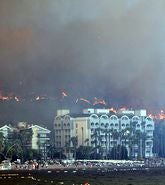As the market for physical climate risk solutions grows, both the degree of divergence and uncertainty remains very high for risk scoring estimates across different applications, making it nearly impossible for customers to confidently navigate physical climate risk.
The limitations of using publicly available climate model scenarios were recently discussed in a Finance Research Letters paper published earlier this year, with the authors highlighting these scenarios as a leading cause of divergence across market-leading solutions seeking to quantify climate change risks.
In addition, if most market solutions are all employing the same publicly available climate scenario data, then why is there such a range of predicted hazard risk outcomes?
The answer is that each application has a unique approach to applying this somewhat coarse publicly available model data within their high-resolution and customized forward-looking time horizons – which are essential for estimating climate risk for real assets.
With this puzzling background, if your business is a consumer of climate risk data, my hope is that after reading this blog you will be more confident when deciding which methodologies you want to apply in your selected climate risk solution – and why it matters to your financial management decisions.
Climate Risk Modeling Uncertainties
Climate models allow us to simulate the effect that increasing greenhouse gas concentrations will have on temperatures, humidity, precipitation, windspeeds, and other climate variables. However, they come with uncertainties.
For example, although modeling resolutions are improving, there are still limitations in their ability to capture all meaningful processes, and therefore cannot be used to directly assess how extreme weather events such as hurricanes or severe convective storms will change in the future.
Therefore, relying directly on downscaled climate model output for quantification of future physical climate risk can lead to erroneous results and poor decisions.
And although there is strong scientific consensus on how climate change is affecting some physical variables such as global mean surface temperatures, consensus for climate change signals in extreme weather varies significantly between perils and regions.
To tackle these issues, RMS combines the benefits of our best-in-class catastrophe models from the (re)insurance industry with the latest climate change science, for both acute and chronic physical risks.
Using robust and peer-reviewed publicly available data enables us to transparently incorporate the latest scientific data and consensus into our models, and RMS takes in a wide range of data sources including:
- Intergovernmental Panel on Climate Change (IPCC) reports
- Coupled Model Intercomparison Project (CMIP) data
- Coordinated Regional Climate Downscaling Experiment (CORDEX) data
- Peer-reviewed scientific research studies
Climate change science is an ever-evolving discipline, and as new data, studies, and modeling projects become available, we update our models frequently to incorporate the latest science.
Forward-Looking View of Climate Risk
If done correctly, combining the catastrophe model framework together with publicly available climate data sets lends itself perfectly to developing forward-looking views of climate risk. One of the common misconceptions about catastrophe models is that they are backward-looking and only represent a historical view.
However, by directly climate conditioning the physical variables that drive these events, and the relevant interactions between these variables, we can fully capture the change in risk that may occur in the future, through both time and space.
Additionally, the RMS climate risk models are underpinned by comprehensive catalogs of 100,000s of possible weather events globally, with each event incorporating detailed hazard footprints that capture wind patterns, precipitation, storm surge, wildfire, droughts, heatwaves, and so on, throughout the full lifecycle of an event.
For example, we account for spatially varying changes in precipitation by climate conditioning our flood models on high-resolution rainfall patterns, rather than just altering water depths in existing flood hazard footprints.
Within the RMS climate risk models, these climate-conditioned event sets are then combined with detailed vulnerability curves that are built on US$100s billion of real-world loss experience to translate the hazard to losses for a multitude of different property and business types across the world. The models can quantify financial loss potential for a range of IPCC Representative Concentration Pathway (RCP) scenarios and time horizons out to 2100.
Integrating Climate-Conditioned Catastrophe Models
As part of Moody’s Analytics, the Moody's RMS climate-conditioned catastrophe models will be integrated within the Moody’s Climate on Demand application in 2023, to deliver forward-looking, physical climate risk quantification to banks, investors, asset managers, and many other organizations who need to understand and better manage their risk and find new opportunities for growth.
I hope this blog has provided a snapshot view of climate risk modeling at RMS. It is undeniable that modeling the impacts of climate change is challenging, computationally intensive, and filled with uncertainties, but our extensive experience in modeling real-world climate impacts provides customers with a robust platform to make decisions with confidence.
With a successful track record of more than 30 years serving the highly regulated insurance industry, our clients know that they are accessing climate-risk intelligence from a tried-and-tested organization and that we understand the rigor, accuracy, and validation required in order for models to be trusted for high stakes financial decision making.
Moody's RMS is excited to tackle the next most urgent integrated risk challenge of our time with you. To learn more about our market-leading solutions today contact us here.





